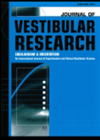
Journal Reviews
Visual vertigo and optokinetic response
This study measured differences in optokinetic responses (sitting, standing, with and without a static visual target) in three groups of people: those classified as having unilateral vestibular loss (n=10), unilateral loss with visual vertigo (n=8) and a control group (n=10)....






